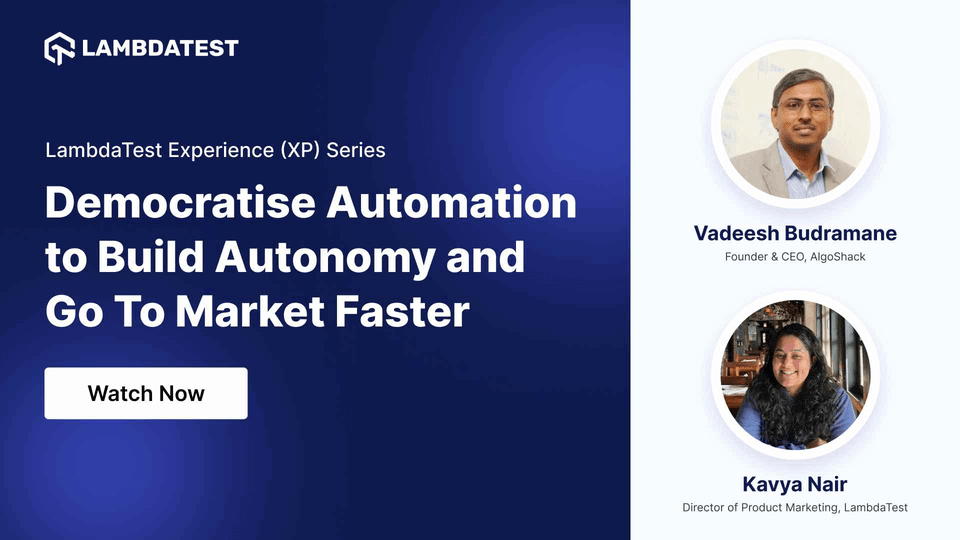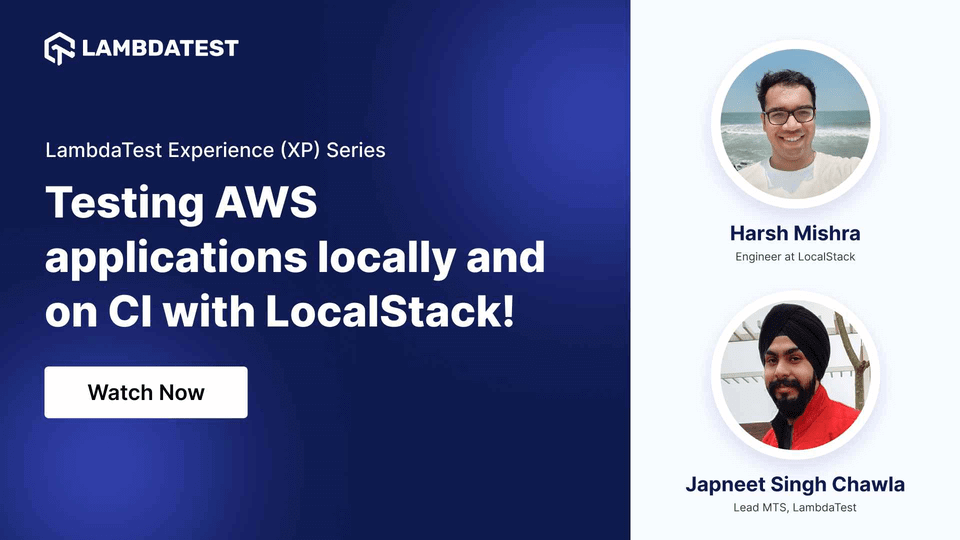XP Series Webinar
Client Feedback & Quality Assurance in Web Design for Agencies
In this webinar, you'll learn about three pillars - web design, client feedback, and quality assurance crucial for crafting exceptional customer experiences in today's dynamic digital landscape.
Listen On

Bhavya Aggarwal
Founder & CEO, zipBoard

Bhavya Aggarwal
Founder & CEO, zipBoard
Bhavya Aggarwal is a tech product CEO based in Vancouver, Canada. With a strong educational background in Aerospace Engineering and prior experience as a Software Developer at Solidworks, she embarked on an entrepreneurial journey, founding her own QA services and Product Management company in India. As the CEO of zipBoard, Bhavya is committed to revolutionizing the review and approval process for digital products.

Harshit Paul
Director of Product Marketing, LambdaTest
Harshit Paul serves as the Director of Product Marketing at LambdaTest, plays a pivotal role in shaping and communicating the value proposition of LambdaTest's innovative testing solutions. Harshit's leadership in product marketing ensures that LambdaTest remains at the forefront of the ever-evolving landscape of software testing, providing solutions that streamline and elevate the testing experience for the global tech community.
The full transcript
Harshit Paul (LambdaTest) - Hello and welcome everyone to the very first episode of LambdaTest XP Series. I'm Harshit Paul, Director of Product Marketing at LambdaTest, and I'll be the host for this session. LambdaTest experience or XP Series is an initiative where we deep dive into the world of insights and innovation, featuring renowned industry experts and business leaders in the testing and QA ecosystem.
And joining me today is Bhavya Agarwal, Founder and CEO of ZipBoard who will unravel the intricacies of web design, client feedback, and quality assurance. Three pillar is crucial for crafting exceptional customer experience in today's dynamic digital landscape. Hi, Bhavya. Thank you so much for joining us. And how about you let our listeners know a little bit about yourself.
Bhavya Aggarwal (zipBoard) - Hi, Harshit. Thank you for having me here. This is exciting for sure. Before I get into my experience with web design, I'm going to talk a little about a few fun facts about me. I'm an aerospace engineer, and I don't know how I landed in web design. I've also lived in 10 cities. I'm currently based in Vancouver, Canada. So talking about web design, I have had my experience building products actually led me through a lot experience working with clients overseas and a lot of remote distribution teams.
I feel like that process, although has improved immensely, but I've really started from a time where everything was discussed in spreadsheets and screenshots and 10 different tools to discuss on issues related to web design, which is such a contextual space to speak about. That's a very quick, quick intro about me, but let's talk more.
Harshit Paul (LambdaTest) - Yeah. So let's start off this episode with a very commonly asked question, which is something even I wanted to put out as soon as possible. And that is when you're working on web design and you have client preferences to be handled, striking a balance between these two, between creative design and meeting client preferences can be rather tricky. So what's your approach to navigate this challenge? How do you do it?
Bhavya Aggarwal (zipBoard) - Yeah, sure. Let me share my screen because I had a few slides put together to talk about it. And I understand we can talk without them as well. But obviously, I'm a very visual person. That's what has led to the board. Right. So can you see the screen? OK, wonderful. So yeah, so really, I mean.
Harshit Paul (LambdaTest) - Likewise, who doesn't like graphics to they can relate to. Yes, I can see that clearly.
Bhavya Aggarwal (zipBoard) - Just to, again, give a background on the story, the whole challenge around the web design is that there are too many pieces, too many people involved, and the process can be very unorganized if you're not on top of it, right? And that relates to that challenge, is that one of the challenges that you've talked about is the fact that, yes, the design wants something else, but the client may want something else.
And in fact, it's interesting that even the client is building for their clients and they may have something else in mind altogether. So having a collaborative system is very important, but essentially what we what we have seen is that some of the issues that challenges that we've seen is that there's a huge disconnect between the person who's delivering and building and the person who's actually being built for the users or in between the clients.
So it ends up becoming a hugely disconnected system. A lot of rework is required. There are project delays all the time. There are payment delays for clients, for agencies. And then there is still a disconnect, a huge disconnect. So I'm not sure if there are straightforward ways to address some of these. But there are tools out there to address some of these challenges.
Harshit Paul (LambdaTest) - Yeah, and I believe pretty much all of it can relate to this part where this ends up being like a Chinese whisperer where by the time you've seen the first requirement and by the time we deliver it, there are some bridges we are never really able to meet. And that's, I guess, the role of having recursive feedback into the process. Right. So, yeah, I can relate to that part clearly.
Bhavya Aggarwal (zipBoard) - Right, right. Yeah. I mean, I don't know if you remember in product management, there's a huge this whole image of where you're trying to build a swing. The client is looking Yeah, yeah. I think it is a common challenge that you know, you're imagining something else and you end up building something else. And that is often because of all the communication and coordination challenges, right?
You're not enabling your people, you're not building a cohesive system in place, you're not taking feedback at every step. There is no way for reviewers, let's say even if it was a swing or a car for that matter, you're not bringing an auto expert right in the beginning and saying, okay, we need your feedback at every step of the way. You're not enabling them properly. They're too busy. and you're asking them for feedback, they don't have time. So how do you really get past some of those challenges?
Harshit Paul (LambdaTest) - Right. And I guess that really is very interesting, because everybody would want to know these strategies that you would recommend in receiving and managing feedback in a way that enhances the design workflow rather than complicating it.
Bhavya Aggarwal (zipBoard) - Right, right. Yeah, and I mean, just again, just to reiterate on, this is my ideal workflow that, okay, you know what? The project team has built something. And of course the web design is complicated because of multiple things as well. There are multiple levels of reviews and types of reviews.
And I think I haven't even addressed all of them here. There is copy, there's design, there is UX, there is compliance, there is translation, responsive design and just so many steps in the way. You have to enable every reviewer in every possible way. And then if you've done that, then your client says, okay, hey, you know what? This looks good.
But obviously, it doesn't happen like this. It ends up being a much more complex process. And I think some of the strategies, since you talked about that, what I can suggest is some of the strategies in which you can improve the overall design coordination is, hey, you need to get your developer and your clients connected in a way that there's no misinterpretation of information.
The feedback comes from the developer, from the client directly to the developer. The feedback comes in a form that the developer understands. They have all the information. They have, they know what browser it was on, you know, what kind of system it was on so that they can reproduce things easily, right? You should not have to have some friction which is caused by system switching, right?
Oftentimes what we've seen is internal teams use tools like JIRA, which is great, you know, lovely tool for developers. They have everything in one place, but the clients have no access to those tools and they do not even want to get into those complex tools, right?
So you want to enable your clients in a way that they are able to leave notes on the design directly. And then those notes directly jump into Jira so that it's all one seems like one whole cohesive system rather than these multiple systems. And, you know, oftentimes design has a lot of creative concepts.
That's what like, you know, there is just so many design elements, copy elements and things like that. So context is important. You need to be able to give context. You need to be able to say, I'm talking about, imagine a 50 page website, being able to do this in a spreadsheet and saying, hey, I want this page, that button doesn't work anymore, right? You should be able to collaborate like you're sitting in the same room, pointed things. And then you want to eliminate your segments.
Like you do not want in between stakeholders, the project manager, the reviewer sending information to client, the client sending information to developer, the developer, oh, project manager, the project manager sending it to developer, you want to bring everybody together, right? And then, of course, for another thing, for agencies, which we often do not even talk about because they're still so stuck in this whole system of not having a system, is that they're not measuring their performance at all then.
Right? They're not seeing that they could have done this project in 50 days instead of the three months or six months that they spent on it. So only if you have one place to see everything, that's when you say, OK, hey, you know what? Yeah, I can figure out where are my inefficiencies. Where are we repeating the same mistakes? What are the QA challenges that we see often enough?
So some of those is what I suggest, like agencies have to think hard about, enabling both the reviewers and the clients and the developers and everybody else in the mix and making it easy in every possible way at every phase.
Harshit Paul (LambdaTest) - Yeah, I guess a lot of time these mishaps happen because of C-load communication, right? So to have a central unified place where everything comes together, right? Right from say rough sketch note to all the way to a detailed document, if you have all of these things stitched in a network that definitely helps with the you shipping up things as per expectations and at a good speed. Yeah. So that really helps.
Bhavya Aggarwal (zipBoard) - Right. And plus, of course, and shifting from just to add, you're shifting from staging to development to production, all of that too, right? You might have something in one phase and may not have. And you may even have a video that you embedded that is broken. So you want everything in one place. All the context is in one place.
Harshit Paul (LambdaTest) - Right, right, that makes sense actually. And this rather comes off as a question which is very vaguely asked. How do you measure client satisfaction in context of web design projects? What metrics do you usually consider valuing in assessing project success?
Bhavya Aggarwal (zipBoard) - Yeah, I mean, there's just too many of them. I feel like, of course, the first and foremost is quality and deliverability on time. I think for a client, those are two very critical items that they care about. Are you able to deliver on time? And are you able to deliver on quality? Because if everything else doesn't work, then it doesn't even matter.
But then of course, on top of that, there are so many other things that come to the mix of a web design, right? Like performance, is my site performing? Is it responsive? Does it work on different devices? Does it work for different localized audiences? So many different things. Or does it work for the search engine? So many different things that you want to take care of, but from a client's perspective, the biggest one is that, is it happening in my budget? Because if you delay timelines my budget skips and you know, it's a mess and it doesn't deliver on the quality that was promised for me Or not and in fact, I can talk a little bit about one of our one of our long-standing client They are called ELM learning and they are based in San Diego and they have been using support with their clients.
They built they built both web design and learning design for some of the large companies like corporate clients like Google, Facebook, Amazon, so a huge roster that they have. And of course, when they're working with such large corporates, it's not a single stakeholder. It's not like a single client person. They have 10 personas within that client as well who will be giving feedback. And with Zapport, they have been able to get their reviews faster by 75%, which is like huge time save for them. They get to do more projects. They get to use their resources better.
And even they're getting to their final version faster as well, which is again a pain. Like you're going through so many versions. There's scope creep. There's a lot of back and forth. If you can get to your final version faster, that's a big win. And they got to their final versions in some projects by almost 50%. And, you know, the creative team has annually saved 5,000 hours. And this is a small agency that I'm talking about, a 50 people agency. We do have some larger agencies as well, where they've seen even more spectacular results, because again, the client is happy, and you know, the team is enabled. Everybody's on the same page.
Harshit Paul (LambdaTest) - I mean, it's true when they say time is money. And being able to save thousands of hours over an annual split by a team that's using to put that time and effort in a place where they can build quality things faster. So enabling them is pretty impressive. These stats look pretty amazing, actually, to me. So yeah, that definitely helps.
Bhavya Aggarwal (zipBoard) - Right, yeah.
Harshit Paul (LambdaTest) - Cool. We've talked about satisfaction of clients, and we've also talked about challenges in general so far, and the ways to strategize them in a way that we are able to mitigate them. But there is one thing that truly intrigues, and it's always about the future. So how do you deliver future-proof web designs? Because web design is such a dynamic space. You have new trends emerging, and there are so many things that you need to make a note of. So how do you make sure that your design of future proofreading.
Bhavya Aggarwal (zipBoard) - Yeah, I mean, I think that's the onus on the client, the agency to of course, first of all, stay informed, right? There is, as you said, there's just too many nuances. There is the search engine algorithm changes every few years, right? Yeah, and then, you know, new devices come every year. So then you have to test for those. And then, you know, there is, you have to care about so many more things if you're working with larger. clients, and you have to care about accessibility today. There's just so many things, but the onus of course lies a lot on the agency to make sure that they are well informed. They put that as part of their review process. They make sure that those are things that are covered.
Like I said, the web design is a complicated industry because there is just, the reviews are many, like from copy to design to search engine reviews and to everything else in between. So it's on the agency to make sure that they inform and they educate their clients and then of course educate their own team as well. And then they factor in time for all those new trends. And of course, I know on top of that, there is the whole AI bandwagon that everybody wants to jump on. But not every shiny object is achievable. So you have to make sure that you are able to say that, okay, you know what, what is doable, what is not. Informing your clients is definitely your like the biggest thing to measure on. Otherwise again, you're in that, you're hoping for something else and you end up having something else altogether.
Harshit Paul (LambdaTest) - Yeah, I guess a lot of that comes down to setting realistic expectations with your clients, right? Because everybody would want the best of the bubble, as you're saying, right? Every time there's a new jargon, everybody wants to go ahead and implement it. But whether it is relevant to your stage at which your product is in right now, to your audience, that is something that has to be set well before time, before you start putting those efforts in that direction.
Bhavya Aggarwal (zipBoard) - Right, absolutely. For sure. Yeah. And of course, there's definitely advantage to a lot of the new tech that's coming though, right? For example, if you take even the example of ChartGPT, you can integrate ChartGPT into your website so quickly and have a automated support system integrated very quickly. So that is the kind of information, again, it's on the agency to inform. Does it make sense? Do you have a repository of questions? Do you want to give generic information or do you want to give more specific information. So I think a lot of the education lies in the hand of the agency.
Harshit Paul (LambdaTest) - Yeah, I think that makes sense, actually. And one thing that I wanted to ask before we wrap this is about demographics. So considering global audiences, you might be involving with different demographics, regions, clients based up their expectations based on those regions. So how do you ensure that web design resonates with diverse cultural preferences and user behaviors?
Bhavya Aggarwal (zipBoard) - Yeah, you know, larger the company that my clients work with, the more of that comes in picture more and more, because obviously there's more languages to support. That's like the basic, first of all, to just be able to localize for different, and then be able to review based on those. So some of our clients use, they translate their designs into seven languages with every language the format changes. Some languages have longer font or longer sentences. So things run out of the designated width or whatnot. So they have to test for each of those scenarios as well. So those are some of the key considerations to think about when you're looking at a diverse global audience supporting different countries. And then, of course, even design aesthetics. Like I know that.
When you go to Japan, they love to have multiple widgets in their design. So then you have to sometimes even localize the design aesthetic for different audiences. Of course, depending on how big your audience is in that geography, you cannot really take care of. And compliance, GDPR and so many other things that have come up which are like, okay, we need to make sure that we are compliant in that particular region as well. So some of those again I would say account for those reviews in that process even if they are end of the process end of your entire web design process but it's actually they are very critical pieces and they tend to delay and slow down things quite a bit if you have not factored into those things as well.
Harshit Paul (LambdaTest) - Right, that makes sense actually. And with that, I have no further questions to ask so far. So thank you so much for joining us Bhavya on this episode, the very first episode of Lambda 6v series. It's been an honor to have you and lovely to host you, of course. I'm sure the listeners would find valuable learnings from this particular episode and take that into, take something back to the practice board. Right. And thank you so much for your time and have a good day.
Bhavya Aggarwal (zipBoard) - Wonderful. Thank you so much, Harshad. This was a lot of fun and I wish you guys all the best. I would look forward to all the episodes that come forward and then I hope there's a lot of new interesting learnings and tidbits that people could get away with. And just as a closing note, if somebody wants to get in touch with me, please reach out to me on LinkedIn or you can reach out to us at zipfood.co. And yeah, this was a great conversation. Thank you so much again.
Harshit Paul (LambdaTest) - Likewise, thank you so much for being here. Thanks for your time. Take care.
Past Talks
 Democratize Automation to Build Autonomy and Go-To-Market Faster
Democratize Automation to Build Autonomy and Go-To-Market FasterIn this webinar, you'll explore how democratizing automation is redefining organizational dynamics, cultivate autonomy, and go-to-market faster than ever before.
Watch Now
 Testing AWS Applications Locally and on CI with LocalStack
Testing AWS Applications Locally and on CI with LocalStackIn this XP Series webinar, Harsh Mishra, Engineer at LocalStack showcases live demostrations, advanced features, and provide highlights on how LocalStack Integrates with LambdaTest HyperExecute for Faster Test Execution.
Watch Now
 Digital Experience Testing: Need of the Hour for Enterprises
Digital Experience Testing: Need of the Hour for EnterprisesIn this webinar, we deep dive into the importance of digital experience testing across multiple devices and platforms, ensuring optimal performance, usability, and accessibility.
Watch Now




